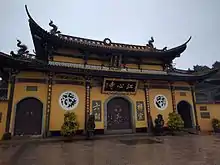Jiangxin Temple
Jiangxin Temple (Chinese: 江心寺; pinyin: Jiāngxīn Sì) is a Buddhist temple located on Jiangxin Island, in Lucheng District of Wenzhou, Zhejiang, China.[1][2]
| Jiangxin Temple | |
|---|---|
江心寺 | |
 A panoramic view of Jiangxin Temple on Jiangxin Island. | |
| Religion | |
| Affiliation | Buddhism |
| Deity | Chan Buddhism |
| Leadership | Shi Zhiming (释智明) |
| Location | |
| Location | Jiangxin Island, Lucheng District, Wenzhou, Zhejiang |
| Country | China |
 Shown within Zhejiang | |
| Geographic coordinates | 28°01′57″N 120°39′12″E |
| Architecture | |
| Style | Chinese architecture |
| Date established | 866 |
| Completed | 1952 (reconstruction) |
| Website | |
| www | |
History

Tang dynasty
The temple was first built with the name of "Puji Chan Temple" (普济禅院) in 866, in the reign of Emperor Yizong (860–874) of the Tang dynasty (618–907). It was renamed "Longxiang Chan Temple" (龙翔禅寺) in 1131, in the Shaoxing period (1127–1162) of Southern Song dynasty (1127–1279). Because the temple situated in the middle of the Ou River, it more commonly known as the "Jiangxin Temple" (江心寺; "Jiang" means river and "Xin" means middle).[1][3]
Song dynasty
In 969, under the rule of Emperor Taizu (960–976) of the Northern Song dynasty (960–1127), the Jingxin Jiangyuan (净信讲院) was erected in its east.[3]
People's Republic of China
After the founding of the Communist State, local government renovated and refurbished the temple.[3]
Jiangxin Temple has been inscribed as a National Key Buddhist Temple in Han Chinese Area by the State Council of China in 1983.[3]
The temple has been designated as a provincial level cultural heritage by the Zhejiang Provincial Government in 2011.[3]
Architecture

Now the existing main buildings include Shanmen, Heavenly Kings Hall, Mahavira Hall, Yuantong Hall, Hall of Three Saints, East Pagoda, and West Pagoda.
Yuantong Hall
In the center of the Yuantong Hall (圆通殿) enshrines the statue of Guanyin with Shancai standing on the left and Longnü on the right. Statue of Maitreya is enshrined at the back of Guanyin's statue. Under the eaves is a plaque with the Chinese characters "Yuantong Hall" written by Qianlong Emperor (1736–1795) in the Qing dynasty (1644–1911).
Hall of Three Saints
The Hall of Three Saints enshrining the statues of Three Sages of the West (西方三圣), namely Guanyin, Amitabha and Mahasthamaprapta.
East Pagoda

The East Pagoda was originally built in 869 or 969 and rebuilt in the following dynasties many times. Hexagon in shape, it has seven stories with the height of 28-metre (92 ft). The pagoda originally had rafters and corridors, in 1894, the British government established the British Consulate in Wenzhou near the pagoda, and forced local government to demolish the rafters and corridors.[1]
West Pagoda

The West Pagoda was first built in 869 or 969 and underwent three largely renovations, respectively in the ruling of Hongwu Emperor (1368–1398) in the Ming dynasty (1368–1644), in the reign of Wanli Emperor (1573–1620) and in the Qianlong period (1736–1796) of the Qing dynasty (1644–1911). The seventh storeys, 32-metre (105 ft) tall, Hexagonal-based Chinese pagoda is made of brick and stone. A total of 16 statues of Buddha are carved in the body of the pagoda.[1]
References
- Zhang Yuhuan (2012), p. 60.
- "National Day of the People's Republic of China". Sohu (in Chinese). 2016-10-01.
- 温州江心寺受潮水侵蚀白蚁啃噬 三十年来. iFeng (in Chinese). 2014-03-20.
- Wang Yanqiong (2016-07-02). 江心屿,承载着温州人的诗和远方. zjol.com.cn (in Chinese).
曾有人在《海贼王》的漫画里看到过江心屿东塔。2015年,温州小伙小吴特地写信向作者尾田荣一郎求证。作者回复他:所画正是温州江心屿东塔。
Bibliography
- Zhang Yuhuan (2012). "The Singularity of the Location of Buddhist Temples in China: Buddhist Temple on the Island" 《中国寺院选址的奇异之处:孤岛寺院》. 《图解中国佛教建筑》 [Illustration of Buddhist Architecture in China] (in Chinese). Beijing: Contemporary China Publishing House. ISBN 978-7-5154-0118-8.